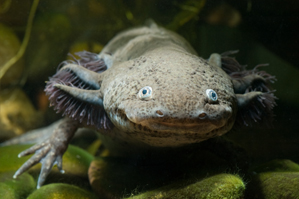Guest post: The a-capella-singing salamander scientist

Today’s guest post comes to you from the capable hands of blossoming science writer Gwen Schanker, AMD’18. Schanker just completed her first year at Northeastern, where she studies journalism and biology. She is a regular contributor to The Huntington News and the NU Science Magazine, as well as several other publications around the web. You can find more of her writing at her own blog, Confessions of an Aspiring Science Journalist.
Axolotl salamanders’ ability to regrow their limbs has been on scientists’ radar since 2006, and research on this phenomenon and the developments it could lead to in regenerative biology hasn’t slowed down since. Not too long ago, Wired Magazine named the Mexican axolotl its “Absurd Creature of the Week.” The hope is that with enough research, biologists will learn the unique conditions under which the salamanders’ limbs regenerate after being amputated.
Studying these creatures requires the dedication of teams from all over, including a group of Northeastern students—both undergraduate and graduate—who work with biology professor James Monaghan to examine the genomes of axolotl salamanders and to determine the factors required for regeneration.
It’s no secret that Northeastern is abuzz with scientific inquiry, and the researchers struggling for answers aren’t hard to find either. When I found out that Dan Humphrey, S’18, a second-year biochemistry major with whom I walk back and forth from tutoring math at the Yawkey Boys and Girls Club on Tuesday afternoons, who is also part of the on-campus a cappella group Distilled Harmony, was a recently integrated member of Monaghan’s research team, I saw an opportunity to hone my skills as a science writer.
And so, in an interview at Monaghan’s lab in mid-April, I met up with Humphrey to discuss what the researchers are doing and why it’s important. Through a Q-and-A followed by countless clarification questions, which Humphrey answered with the help of some of his colleagues, I gradually began to understand the details of the lab and the work the students do on a daily basis.
The salamanders are kept in a light- and temperature-controlled space and are used to examine how factors like chemical and light exposure affect limb regeneration. The researchers use retinoic acid, which Monaghan discovered was a key to regeneration when he was a postdoctoral student at the University of Florida. When retinoic acid is added to a severed part of the salamander’s body, it causes the limb to regrow from the beginning.
To observe the regeneration process, the researchers use cloning to create probes which bind to a site on the salamander through fluorescent in situ hybridization, also known as FISH. The probes attach to antibodies on a specific mRNA protein, which is viewed under a fluorescence microscope.
To regrow their limbs, the salamanders undergo a series of steps not unlike the steps the human body goes through after an injury. No research team has determined exactly where the human healing process differs from the axolotl regeneration process—that is, what genes are switched on and off at what times.
That’s hardly surprising, considering the salamanders have an estimated 10 times as much DNA as humans do. Partly for that reason, the researchers are still some distance away from human limb regeneration.
Whether he’s slicing strands of DNA through gel electrophoresis or cleaning the salamanders’ tanks, Humphrey loves working in the lab. He will be on co-op next semester at Massachusetts General Hospital, studying the inherited disorder Mucolipidosis Type IV, but Humphrey hopes to stay involved if he can. According to Humphrey, becoming part of Monaghan’s team required a sending a number of “insanely persistent” emails and acclimating to a substantial learning curve, but he assured me the experience has been well worth it.
And my experience? Well, I’ve still got a ways to go before I understand all the steps of FISH, let alone how to integrate them into a set of interview questions. Nevertheless, I know a lot more about regenerative biology than I did two months ago.
Furthermore, after learning that my a-cappella singing, Tuesday-afternoon math tutoring friend is part of such an impactful project, I can’t help but wonder what other life-changing research the students I spend time with each week are involved in. It’s become clear in my first year here that Northeastern is a hub for scientific research and discussion, and I’m excited to become a more integral part of it all.





